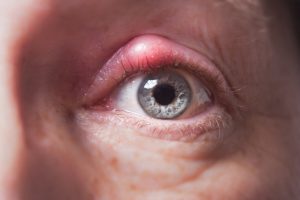
Styes are pretty obvious, and if you have one, you’ll surely know it once you spot a lump on your eyelid. It may look like a pimple or boil. Your eyelid may also feel painful, swell, and turn red.
A stye can appear unsightly, but is it contagious? Let’s take a look.
Is a stye contagious?
There is no definitive answer to the question, is a stye contagious? In fact, there is no consensus even in the medical community. A stye usually develops when bacteria multiply in the eyelid. Because these bacteria usually don’t travel from person to person, some experts insist that a stye is not contagious.
On the other hand, if a person comes into contact with the bacteria, then touches their eye and develops a stye as a result, then this implies it is possible to pass the infection to others (though this is quite rare). Based on this explanation, a stye can be considered contagious.
Looking for a middle-ground in this debate, one might suggest that a stye is not contagious, unless certain conditions are met, such as contact transmission of bacteria by touching the stye and then touching the eye.
Home remedies to prevent stye
A stye will often clear up on its own. If not, your doctor may prescribe antibiotic eye drops. If medication doesn’t help either, your doctor will cut open the stye to drain the pus and promote healing.
To manage your stye at home, avoid touching it, clean your eyelid, place a warm washcloth over the eye a few times a day, keep your eye clean, don’t wear makeup while you have a stye, and avoid wearing contact lenses until it clears up.
Here are some remedies you can try at home if you spot a stye on your eyelid:
- Apply warm compresses
- Massage the eyelid to speed up drainage
- Place clean and warm guava leaves on the eye
- Make a solution with acacia leaves and apply it to the eye
- Mix apple cider vinegar with warm water and soak a cotton ball to place on the eye
- Use a cotton swab to put on castor oil to the area
- Apply green tea bags to the eye
- Cut open aloe vera leaves and place on the eyelid
- Boil parsley and use the water on the eyelids
- Always maintain proper hygiene: wash your wash, don’t touch your eyes with dirty hands, and protect your eyes from dirt and pollution.